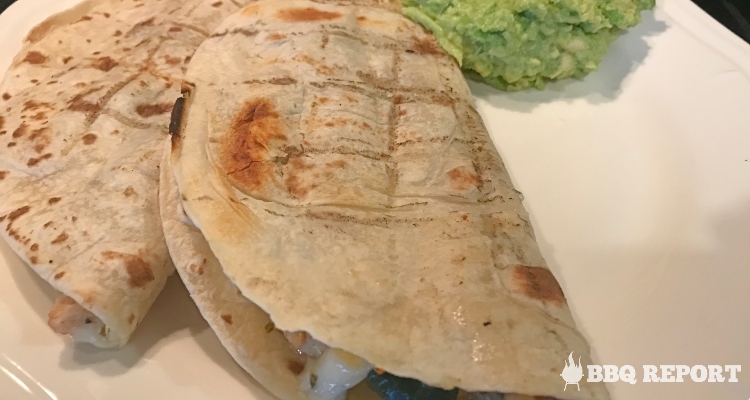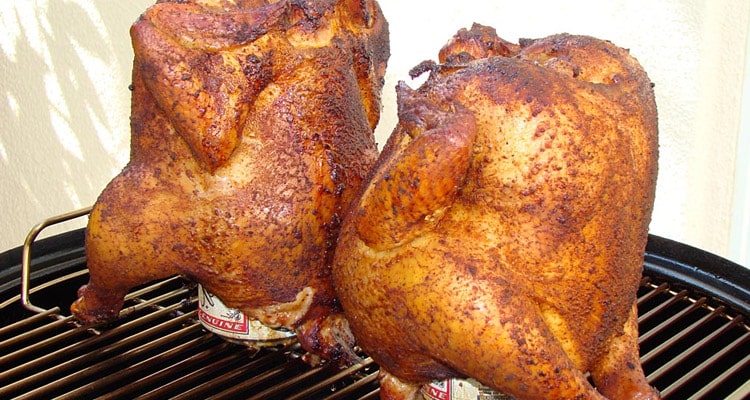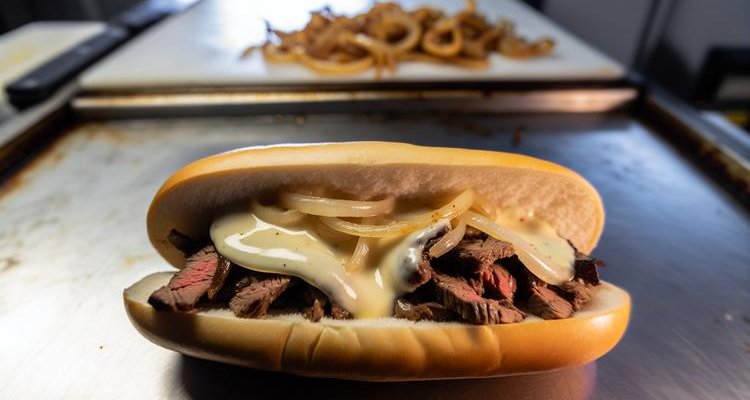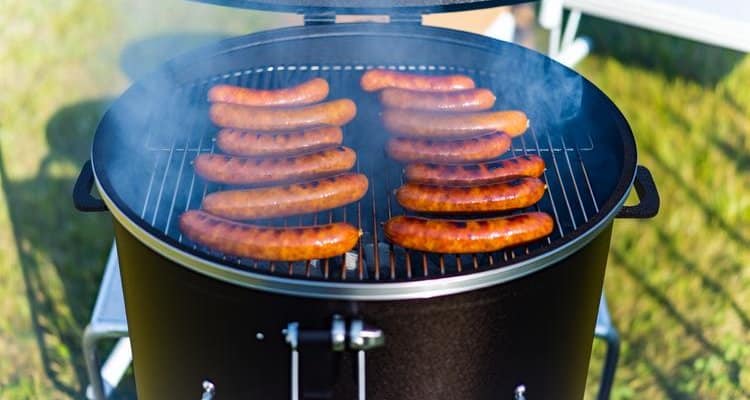
Imagine biting into perfectly smoked sausage with crispy, golden-brown casings and a juicy, flavorful interior. The satisfaction of achieving restaurant-quality smoked sausage at home is within reach for any BBQ enthusiast. Whether you’re working with bratwurst, Italian sausage, or breakfast links, mastering the art of how to smoke sausage opens up a world of incredible BBQ possibilities.
Many beginners struggle with split casings, dry sausage, or inconsistent results when they first attempt smoking sausage. The good news? These common pitfalls are entirely avoidable when you understand the fundamentals of smoking sausage temperature control, proper spacing techniques, and timing guidelines.
This comprehensive guide covers everything you need to know about how to smoke sausage, from selecting the right wood to achieving perfect internal temperatures. You’ll learn proper techniques for smoking sausage temperature management, discover how long to smoke sausage of different varieties, and understand which woods produce the best flavor profiles. By the end of this guide, you’ll have the confidence to achieve professional-quality smoked sausage on your first attempt, complete with troubleshooting strategies and food safety best practices.
- Getting Started: Understanding Sausage Types
- Setup: Essential Equipment
- Wood Selection: Choosing the Right Wood
- Preparation: Preparing Your Sausages
- Process: Step-by-Step Guide
- Timing: Temperature and Timing
- Troubleshooting: Common Mistakes
- Safety: Food Safety
- Serving: Serving and Storage
Understanding Sausage Types for Smoking
Before learning how to smoke sausage effectively, you need to understand the different sausage categories and how they impact your smoking approach. The type of sausage you choose determines both the smoking sausage temperature and how long to smoke sausage to achieve perfect results.
Fresh vs. Pre-Cooked vs. Cured Sausages
Fresh or raw sausage contains uncooked ground meat and requires full cooking to a minimum internal temperature of 165°F for food safety. These sausages take the longest to smoke but offer the most opportunity to infuse smoke flavor throughout the meat. Popular fresh sausages include bratwurst, Italian sausage, and breakfast links.
Pre-cooked sausage has already been fully cooked during manufacturing and only needs reheating to 140°F when you smoke it. Because they’re already safe to eat, pre-cooked sausages require significantly less time in the smoker—typically just 30-45 minutes. Examples include kielbasa and most hot dogs.
Cured sausage undergoes a special preservation process with salt and nitrites. While some cured sausages can be smoked, they require different handling than fresh or pre-cooked varieties and are beyond the scope of this beginner’s guide.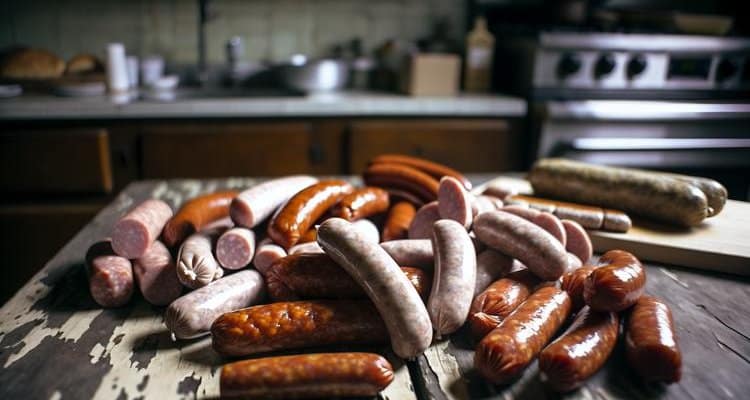
Popular Sausage Varieties for Smoking
Bratwurst is a German-style fresh sausage made from pork (sometimes mixed with veal) with a mild, slightly sweet flavor profile. Brats have a thick diameter and natural casings that crisp beautifully when smoked at the proper temperature.
Italian sausage comes in mild and spicy varieties, featuring fennel and garlic seasonings. The fresh links are perfect for smoking and pair exceptionally well with fruit woods like apple or cherry.
Chorizo is a spicy, heavily seasoned sausage available in both fresh Mexican and cured Spanish varieties. Fresh chorizo smokes beautifully but requires careful temperature control due to its high fat content.
Kielbasa is a pre-cooked Polish sausage that’s already smoked at the factory. While technically ready to eat, additional smoking enhances its flavor significantly.
Breakfast sausage links are smaller, thinner fresh sausages that smoke quickly—usually in 1-1.5 hours. Their size makes them ideal for beginners learning how to smoke sausage.
Size and Casing Considerations
Sausage diameter dramatically affects how long to smoke sausage to reach safe temperatures. Thick bratwurst (1-1.5 inches diameter) can take 2-3 hours, while thin breakfast links (0.5-0.75 inches) may finish in just 90 minutes.
Natural casings from animal intestines are traditional and provide excellent “snap” when bitten. They’re more delicate than synthetic casings and require gentle temperature control to prevent splitting. Synthetic casings are more forgiving for beginners but don’t crisp quite as nicely.
| Sausage Type | Raw/Pre-cooked | Smoking Time | Internal Temp Target | Notes |
|---|---|---|---|---|
| Bratwurst | Raw | 2-3 hours | 165°F | Thick diameter, natural casing |
| Italian Sausage | Raw | 2-2.5 hours | 165°F | Pairs well with fruit woods |
| Chorizo | Raw (Mexican) | 2-2.5 hours | 165°F | High fat, watch for flare-ups |
| Kielbasa | Pre-cooked | 30-45 minutes | 140°F | Great for beginners |
| Breakfast Links | Raw | 1-1.5 hours | 165°F | Thin diameter, quick cook |
| Hot Dogs | Pre-cooked | 30-45 minutes | 140°F | Already fully cooked |
Essential Equipment and Setup
Having the right equipment makes learning how to smoke sausage significantly easier and more successful. While you don’t need expensive gear to start, certain tools are non-negotiable for food safety and quality results.
Smoker Types for Sausage
Offset smokers use a separate firebox to generate smoke that flows through the main cooking chamber. They offer authentic BBQ flavor and excellent temperature control once you master fire management. The traditional method requires more attention but produces superior smoke flavor.
Electric smokers are the easiest option for beginners learning how to smoke sausage. They maintain consistent smoking sausage temperature with minimal intervention, though they produce less intense smoke flavor than charcoal or wood-fired units.
Pellet grills automate temperature control while burning compressed wood pellets. They’re excellent for maintaining the steady 225-250°F range ideal for smoking sausage temperature consistency.
Charcoal smokers like kettle grills and Kamados provide classic BBQ flavor at an affordable price point. They require more temperature monitoring than electric or pellet smokers but are highly effective for how to smoke sausage when managed properly.
Required Tools
Instant-read thermometer: This is the single most critical tool for learning how to smoke sausage safely. Never rely on cooking time or visual cues alone. Insert the thermometer through the end of the sausage to check internal temperature without piercing the casing sides. A quality instant-read thermometer ensures you hit the target smoking sausage temperature every time.
Digital probe thermometer: For continuous monitoring, a probe thermometer with dual sensors lets you track both smoker temperature and internal sausage temperature simultaneously without opening the lid.
Long-handled tongs: Prevent burns while rotating sausages during the smoking process. Choose tongs with at least 12-inch handles for safety.
Drip pan: Place a pan filled with water beneath the sausages to catch drippings, prevent flare-ups, and help maintain consistent temperature.
Water pan: This essential but often overlooked tool is critical for beginners. A water pan placed in your smoker serves two vital purposes: it stabilizes temperature by acting as a heat sink, and it maintains humidity to prevent sausages from drying out during the long smoking process. Fill it with hot water before starting and monitor the level throughout your cook.
Optional but Helpful Accessories
Sausage hangers allow you to hang sausages vertically in cabinet-style smokers, promoting even smoke circulation and preventing “bald spots” where sausages touch the grate.
Temperature alarms alert you when smoker temperature drifts outside your target range or when sausages reach the desired internal temperature.
BBQ gloves protect your hands when handling hot grates or rotating sausages mid-cook.
Large bowl for ice water bath helps prevent wrinkled casings after smoking—a professional finishing technique we’ll cover in the troubleshooting section.
Choosing the Right Wood for Smoking Sausage
Selecting the best wood for smoking sausage dramatically impacts the final flavor profile. Different woods pair better with specific sausage types, and understanding these pairings elevates your results from good to exceptional.

Wood Flavor Profiles
Hickory delivers a strong, bacon-like flavor that’s the classic choice for pork sausages. It’s the traditional wood for smoking sausage in American BBQ but can become overpowering if you use too much. Hickory pairs exceptionally well with bratwurst and Italian sausage.
Mesquite produces an intense, earthy smoke flavor—the strongest of all smoking woods. Use mesquite sparingly with sausage, as its boldness can overpower the meat’s natural flavors. Reserve mesquite for heavily spiced sausages like chorizo.
Oak provides a medium-strength, versatile smoke that complements virtually any sausage type. It’s forgiving for beginners and produces consistent results without risk of over-smoking.
Pecan offers a mild, nutty flavor similar to hickory but more subtle. It’s excellent for sausages with delicate seasonings where you want smoke presence without dominance.
Apple and cherry are fruit woods that deliver mild, slightly sweet smoke perfect for pork sausages. These are the best wood for smoking sausage when you want smoke flavor that enhances rather than overwhelms. Our comprehensive guide to smoking woods provides detailed pairing recommendations.
Maple provides gentle, sweet smoke that works beautifully with breakfast sausages and milder varieties.
How Much Wood to Use
When learning how to smoke sausage, less is more with wood. Start with 2-3 small chunks (fist-sized) or 1-2 cups of wood chips. This provides 1.5-2 hours of smoke, which is the maximum recommended smoke exposure for sausage.
Add wood only during the first 1.5-2 hours of smoking. After this period, sausages stop absorbing significant smoke flavor, and additional smoke just creates bitter, acrid flavors. Finish cooking without adding more wood.
Signs of too much smoke include thick, white billowing smoke (clean smoke is thin and blue-gray), bitter taste in the finished product, and sausages that are dark brown or blackened rather than golden-brown.
| Wood Type | Flavor Profile | Intensity | Best Pairings | Notes |
|---|---|---|---|---|
| Hickory | Bacon-like, traditional BBQ | Strong | Bratwurst, Italian sausage | Classic choice, use moderately |
| Mesquite | Intense, earthy | Very Strong | Chorizo, spicy sausages | Easy to overpower, use sparingly |
| Oak | Traditional, balanced | Medium | All sausage types | Versatile, beginner-friendly |
| Pecan | Nutty, subtle | Medium | Mild Italian, chicken sausage | Similar to hickory but milder |
| Apple | Fruity, sweet | Mild | Pork sausages, breakfast links | Can’t over-smoke with apple |
| Cherry | Fruity, slightly sweet | Mild | All pork sausages | Beautiful mahogany color |
| Maple | Sweet, delicate | Mild | Breakfast sausage | Excellent for poultry sausages |
Preparing Sausage for Smoking
Proper preparation before smoking makes the difference between good and great results when you learn how to smoke sausage. These simple but crucial steps ensure even cooking and maximum flavor.
Temperature Preparation
Remove sausages from the refrigerator 30-60 minutes before smoking to bring them closer to room temperature. This promotes more even cooking throughout the sausage, preventing cold centers when the exterior reaches target temperature.
Cold sausages placed directly in a hot smoker can cause casings to contract rapidly and split. The gradual warm-up period allows casings to relax, significantly reducing the risk of bursting.
For food safety, don’t leave raw sausage at room temperature for more than 60 minutes. If your kitchen is very warm (above 75°F), reduce this time to 30 minutes.
Pat sausages dry with paper towels before smoking. Surface moisture prevents proper smoke ring formation and delays browning. A dry surface allows smoke to adhere better and develops that desirable golden-brown color more quickly.
To Prick or Not to Prick: Myth Busting
The myth that you should prick sausages to “release steam” and prevent bursting is completely false. When you poke holes in sausage casings, you create escape routes for valuable juices and fats—the very elements that keep smoked sausage moist and flavorful.
Natural casings are designed to expand slightly as the sausage cooks, allowing steam to release gradually through the casing’s natural permeability. This process happens automatically at the proper smoking sausage temperature (225-250°F).
Casings split from excessive heat, not from internal pressure. The solution is correct temperature control, not poking holes that ruin the sausage.
Seasoning and Oiling
Most sausages are pre-seasoned and don’t require additional spices. However, you can brush sausages lightly with vegetable oil or olive oil before smoking. This thin coating promotes even browning and helps prevent sticking to grill grates.
Avoid heavy oils like butter, which can drip and cause flare-ups. A light misting with cooking spray works well if you prefer that method.
If you want to add external seasoning, stick to simple options like coarse black pepper or a light dusting of your favorite BBQ rub. Remember that the sausage’s internal seasonings are already balanced—external additions should complement, not compete.
Step-by-Step Smoking Process
This section walks you through exactly how to smoke sausage from start to finish. Follow these steps carefully for consistent, professional-quality results every time.
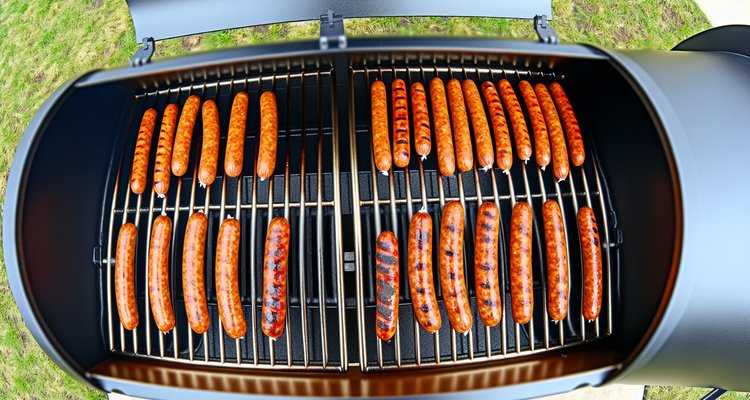
Step 1: Preheat Your Smoker
Target a smoking sausage temperature of 225-250°F before adding your sausages. This range provides gentle, even cooking that prevents casing splits while ensuring food safety.
Preheat for at least 20-30 minutes to stabilize the temperature and burn off any manufacturing oils if using a new smoker. Add your initial wood chunks or chips during preheating so you have clean, thin blue-gray smoke—not thick white smoke—when sausages go in.
Fill your water pan with hot water during preheating. Hot water brings the smoker to temperature faster and immediately begins providing humidity.
Step 2: Arrange Sausages Properly
When sausages touch each other or are too close, smoke can’t circulate around the entire surface. This creates “bald spots”—pale, unsmoked areas where the sausages touched. These spots not only look unappealing but also lack the smoke flavor you’re working to achieve.
Place sausages on the middle rack of your smoker for the most even heat distribution. Top racks may be too hot, while bottom racks near the heat source can cook unevenly.
Avoid overcrowding even if it means smoking in multiple batches. Quality results come from giving each sausage room to breathe.
Step 3: Monitor Temperatures Carefully
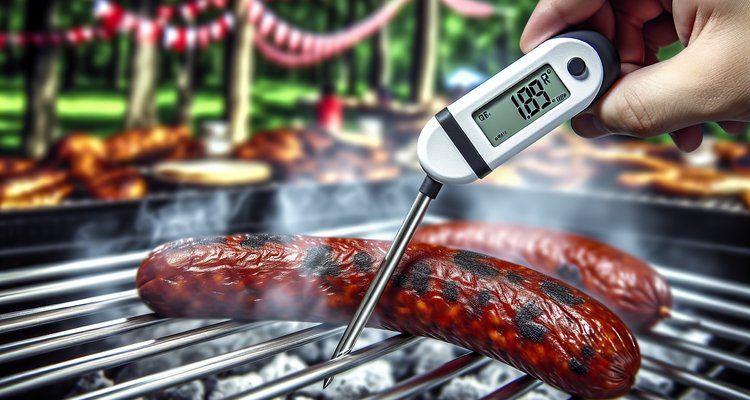
Maintain smoker temperature at 225-250°F throughout the cook. Check every 30-45 minutes and adjust vents, fuel, or controls as needed to stay in this range.
For internal sausage temperature, don’t check constantly—each time you open the smoker, you lose heat and smoke. Check internal temperature starting at the 90-minute mark for thin sausages or 2-hour mark for thick sausages.
Insert your instant-read thermometer through the end of the sausage, not through the side. This technique checks the center temperature without creating juice-leaking holes in the casing.
Target 165°F for fresh sausage or 140°F for pre-cooked varieties. Remember that temperature will continue rising 10-15°F during resting, so you can remove sausages at 155-160°F for fresh sausage.
Step 4: Managing Smoke and Wood
Add wood only during the first 1.5-2 hours of smoking. This is the optimal smoke absorption window—after this period, sausages develop a “bark” that prevents additional smoke penetration.
Good smoke is thin and blue-gray, almost invisible. Thick white smoke indicates incomplete combustion and creates bitter flavors. If you see billowing white smoke, increase airflow to your fire.
Don’t worry if smoke production varies slightly throughout the cook—this is normal, especially with chunk wood. As long as you see occasional wisps of smoke and maintain proper temperature, your sausages are absorbing flavor.
After 2 hours, you can continue cooking without any smoke at all. The sausages just need to reach safe internal temperature at this point—more smoke won’t improve flavor and may create bitterness.
Step 5: Rotating and Flipping
Rotate sausages every 45 minutes to promote even cooking and color development. Turn them 180 degrees and flip them over for uniform smoke exposure on all sides.
Signs of uneven cooking include one side significantly darker than the other, or sausages closest to the firebox cooking faster than those farther away. These hot spots are normal in most smokers—rotation solves the problem.
Use long-handled tongs to rotate sausages quickly, minimizing the time your smoker lid is open and temperature is dropping.
| Sausage Type | Smoker Temp | Target Internal Temp | Approx Time | Key Steps |
|---|---|---|---|---|
| Fresh Bratwurst | 225-250°F | 165°F | 2-3 hours | Rotate every 45 min, smoke for 2 hours max |
| Italian Sausage | 225-250°F | 165°F | 2-2.5 hours | Watch for fat flare-ups, use drip pan |
| Breakfast Links | 225-250°F | 165°F | 1-1.5 hours | Check temp at 90 min, quick cook |
| Pre-cooked Kielbasa | 225-250°F | 140°F | 30-45 minutes | Just reheating and adding smoke |
| Hot Dogs | 225-250°F | 140°F | 30-45 minutes | Great beginner project |
Temperature and Timing Guide
Mastering smoking sausage temperature and understanding how long to smoke sausage are the two most critical factors for success. This section provides the specific numbers you need for food safety and optimal results.
Critical Temperature Guidelines
For fresh sausage made from raw ground meat, 165°F is non-negotiable. This temperature ensures any harmful bacteria like Salmonella or E. coli are completely eliminated.
Pre-cooked sausage only needs to reach 140°F since it’s already been fully cooked during manufacturing. You’re reheating and adding smoke flavor, not cooking for safety.
Account for temperature rise during resting. When you remove sausages from heat, internal temperature continues climbing 10-15°F as heat redistributes from exterior to center. This means you can pull fresh sausage at 155-160°F—it will coast to 165-170°F during the rest period.
Timing by Sausage Type
Large bratwurst (1-1.5 inches diameter) typically requires 2-3 hours at 225-250°F smoking sausage temperature to reach 165°F internal temperature. Thicker sausages from cold refrigerator temperatures may push toward the 3-hour mark.
Thin breakfast links (0.5-0.75 inches diameter) cook much faster, usually reaching 165°F in just 1-1.5 hours. Check these early and often to prevent overcooking.
Italian sausage falls between bratwurst and breakfast links, typically finishing in 2-2.5 hours depending on thickness. The high fat content can cause slightly longer cooking times.
Pre-cooked sausages like kielbasa and hot dogs only need 30-45 minutes to reheat to 140°F and absorb smoke flavor. These are excellent choices when learning how to smoke sausage for the first time.
Factors Affecting Timing
Starting temperature significantly impacts how long to smoke sausage. Cold sausages straight from a 38°F refrigerator take 30-45 minutes longer than room-temperature sausages. This is why the prep step of allowing 30-60 minutes of warm-up time matters.
Sausage diameter is the primary factor in cooking time. A 1-inch diameter sausage has roughly twice the cross-sectional area of a 0.7-inch sausage, requiring significantly more time for heat to penetrate to the center.
Weather and ambient temperature affect smoker performance. Cold winter days require more fuel and longer preheating. Wind can destabilize temperature even with good smoker design.
Smoker type variations mean offset smokers may cook slightly faster due to direct heat exposure, while electric smokers provide very consistent times due to precise temperature control.
Visual and Tactile Indicators
Color changes from pale pink to golden-brown indicate proper smoke penetration and browning. However, color alone doesn’t indicate doneness—some sausages brown quickly while remaining undercooked inside.
Firmness to touch evolves as sausages cook. Raw sausage feels soft and squishy; fully cooked sausage feels firm but still has some give. Overcooked sausage feels hard and dry.
Casing appearance shifts from translucent and shiny to opaque and slightly wrinkled. Some wrinkling is normal and even desirable—it indicates moisture loss and smoke absorption.
| Sausage Type | Smoker Temp | Internal Temp Target | Approximate Time | Thickness | Notes |
|---|---|---|---|---|---|
| Bratwurst (fresh) | 225-250°F | 165°F | 2-3 hours | 1-1.5 inches | Remove at 155°F, rest to 165°F |
| Italian (mild/spicy) | 225-250°F | 165°F | 2-2.5 hours | 1-1.25 inches | High fat content, use drip pan |
| Chorizo (fresh) | 225-250°F | 165°F | 2-2.5 hours | 1-1.5 inches | Very high fat, watch for flare-ups |
| Breakfast Links | 225-250°F | 165°F | 1-1.5 hours | 0.5-0.75 inches | Check temp starting at 90 minutes |
| Kielbasa (pre-cooked) | 225-250°F | 140°F | 30-45 minutes | 1-1.5 inches | Just reheating, great for beginners |
| Hot Dogs (pre-cooked) | 225-250°F | 140°F | 30-45 minutes | 0.75-1 inch | Perfect practice project |
| Chicken/Turkey Sausage | 225-250°F | 165°F | 1.5-2 hours | 0.75-1 inch | Lean meat, watch for drying |
Common Mistakes and Troubleshooting
Even experienced pitmasters encounter issues when learning how to smoke sausage. Understanding these common problems and their solutions prevents frustration and ensures success.
Split or Burst Casings
Cause: Excessive heat is the primary culprit. When smoker temperature exceeds 275°F, casings contract rapidly and split open, releasing all the flavorful juices you worked to preserve.
Cause: Poking holes before smoking weakens the casing structure, creating weak points that tear under pressure.
Solution: Maintain smoking sausage temperature between 225-250°F. Use a reliable thermometer to monitor smoker temperature, not just the built-in gauge (which can be off by 25-50°F).
Solution: Ensure gentle, consistent heat throughout the cook. Avoid temperature spikes by managing fuel and airflow carefully.
Dry, Tough Sausage
Cause: Overcooking past 165°F internal temperature drives out moisture and makes sausage dry and rubbery. Every degree above 165°F exponentially increases moisture loss.
Cause: Too much smoke exposure (over 2 hours) dries the exterior and creates a thick, tough bark.
Solution: Monitor internal temperature meticulously. Remove fresh sausages at 155-160°F and let carryover heat bring them to 165°F during resting.
Solution: Limit smoke exposure to 1.5-2 hours maximum. After this window, continue cooking without adding more wood.
Solution: Use a water pan to maintain humidity in the smoking environment. The moisture prevents excessive surface drying.
Pale, Undercooked Appearance
Cause: Temperature too low (below 225°F) doesn’t brown the casing properly or develop the smoke ring.
Cause: Insufficient smoke during the first 2 hours means sausages lack the color and flavor smoke provides.
Solution: Increase smoker temperature to at least 225°F, ideally 240-250°F for better browning.
Solution: Add wood chunks or chips during the first 1.5-2 hours to ensure adequate smoke for color development.
Solution: Use a darker wood like hickory instead of mild fruit woods if you want more pronounced color.
Uneven Cooking
Cause: Overcrowding prevents smoke and heat circulation, creating hot and cold spots among sausages.
Cause: Most smokers have hot spots—areas closer to the heat source that cook faster.
Solution: Maintain proper spacing of 2-3 inches between each sausage to allow full smoke circulation.
Solution: Rotate sausages every 45 minutes, moving those in hot spots to cooler areas and vice versa.
Wrinkled Casings After Cooling
Cause: Over-resting causes casings to shrink and wrinkle as they cool and moisture evaporates.
Solution: Use the ice water bath technique: immediately after removing sausages from the smoker, plunge them in a bowl of ice water for 20-30 seconds. This stops the cooking process and sets the casing against the meat, preventing wrinkles.
Solution: Serve hot after just a 3-5 minute rest. Don’t let sausages sit for extended periods before serving.
Bitter, Over-Smoked Flavor
Cause: Too much wood creates creosote buildup—a black, tar-like substance that tastes bitter and acrid.
Cause: Dirty smoke from insufficient airflow or wet wood produces unpleasant flavors.
Solution: Limit smoke to 1.5-2 hours total. After this period, no more wood is needed or beneficial.
Solution: Ensure clean-burning fire with thin, blue-gray smoke. Thick white smoke is a warning sign.
Solution: Use properly seasoned wood with less than 20% moisture content. Wet wood smolders instead of burning cleanly.
Food Safety Considerations
Food safety is paramount when learning how to smoke sausage. Ground meat products like sausage pose higher bacterial risk than whole muscle cuts, making temperature control and proper handling critical.
Critical Temperature Safety
Fresh sausage is made from ground meat, which has significantly more surface area than whole muscle cuts. Grinding disperses bacteria throughout the meat rather than keeping it on the exterior, requiring higher cooking temperatures for safety.
The danger zone is 40-140°F—the temperature range where bacteria multiply rapidly. Sausage should pass through this zone as quickly as possible. At proper smoking sausage temperature (225-250°F), sausages move through the danger zone in 90-120 minutes, which is safe.
Never smoke sausage at temperatures below 200°F for extended periods. While some traditional sausage-making uses lower temperatures, it requires curing salts and specialized knowledge beyond this beginner’s guide.
Safe Handling Practices
Keep raw sausage refrigerated at 38-40°F until 30-60 minutes before smoking. Don’t leave it at room temperature for more than one hour.
Prevent cross-contamination by using separate cutting boards and utensils for raw sausage and ready-to-eat foods. Wash your hands thoroughly with soap and hot water after handling raw sausage.
Clean your instant-read thermometer between temperature checks, especially if you’re checking multiple sausages. Wipe the probe with a clean paper towel or sanitizing wipe to prevent spreading bacteria from one sausage to another.
Resting and Holding Safely
A safe resting period is 3-5 minutes for smoked sausage. During this brief rest, temperature continues rising 10-15°F, juices redistribute, and sausages are still safely above 140°F.
If you need to hold sausages before serving, keep them above 140°F. Place them in a warming drawer, low oven (170-200°F), or insulated cooler with towels.
Maximum hold time before refrigeration is 2 hours above 140°F. After 2 hours at room temperature, bacterial growth becomes a concern even for fully cooked sausage.
Storage and Reheating
Refrigerator storage: Store smoked sausage in airtight containers or heavy-duty freezer bags for 3-4 days. Label with the date and consume within this window for best quality and safety.
Freezer storage: Properly wrapped smoked sausage keeps for 2-3 months in the freezer. Use vacuum sealing or freezer-grade bags to prevent freezer burn.
Proper reheating requires bringing sausage back to 165°F internal temperature. Don’t just warm it—fully reheat it for safety.
Avoid multiple reheat cycles. Each time you heat and cool sausage, you create opportunities for bacterial growth. Reheat only the portion you’ll consume immediately.
| Storage Method | Temperature | Duration | Container Type | Reheating Notes |
|---|---|---|---|---|
| Refrigerator | 38-40°F | 3-4 days | Airtight container or bag | Reheat to 165°F |
| Freezer | 0°F or below | 2-3 months | Vacuum seal or freezer bag | Thaw in refrigerator, reheat to 165°F |
| Room Temperature Hold | Above 140°F | 2 hours maximum | Warming drawer or insulated cooler | Keep above 140°F continuously |
| Danger Zone (Don’t Store) | 40-140°F | Never store in this range | N/A | Discard if held in danger zone over 2 hours |
Serving and Storage
The final steps of resting, serving, and storing your smoked sausage properly ensure you enjoy the fruits of your labor at peak quality.
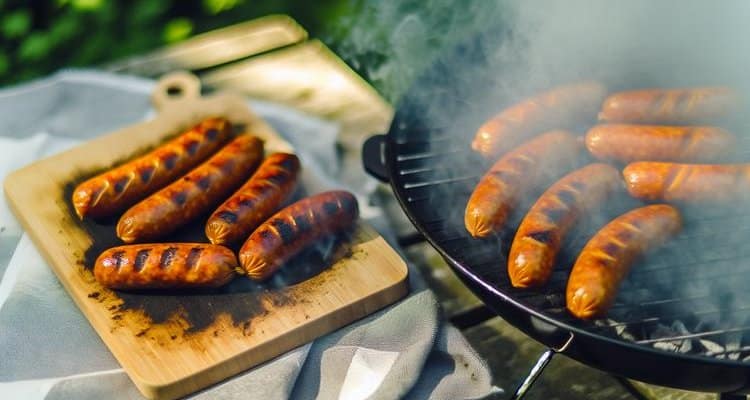
Optimal Resting Period
Rest smoked sausages for 3-5 minutes after removing them from the smoker. This brief period isn’t just tradition—it serves important purposes.
Temperature carryover occurs during resting. The exterior of sausages is hotter than the interior when you pull them from the smoker. During rest, heat migrates inward, raising internal temperature by 10-15°F. This means sausages pulled at 155°F will coast to 165-170°F without additional cooking.
Juice redistribution happens as muscle fibers relax after heat exposure. Cutting immediately causes juices to pour out; resting allows them to be reabsorbed, keeping sausages moist when you bite into them.
However, 10-15 minutes of resting (as recommended by the consensus review) allows sausages to cool below optimal serving temperature and can cause casings to wrinkle as they shrink. For the best balance of juice retention and texture, rest for 10-15 minutes only when you plan to refrigerate sausages for later use. When serving immediately, stick to 3-5 minutes.
Serving Suggestions
Classic presentations include serving smoked sausages in toasted buns with yellow mustard, sauerkraut, and grilled onions. This traditional approach lets the smoke flavor shine.
Sliced smoked sausage works beautifully with BBQ sides like baked beans, coleslaw, potato salad, and cornbread. Slice on a bias for attractive presentation.
In recipes, smoked sausage adds incredible depth to jambalaya, red beans and rice, pasta dishes, and breakfast scrambles. The smoke flavor enhances these dishes significantly compared to using unsmoked sausage.
On charcuterie boards, sliced smoked sausage provides a centerpiece protein alongside cheeses, crackers, pickles, and mustards.
Immediate Consumption vs. Storage
Smoked sausage is best served hot, straight from the 3-5 minute rest. The texture is at its peak—casings are crisp, interior is juicy, and melted fat coats your palate for maximum flavor.
As sausage cools, fat begins to solidify and casings toughen slightly. While still delicious, cold or room-temperature smoked sausage lacks the textural perfection of hot sausage.
If you must hold sausages before serving, keep them above 140°F in a warming drawer, low oven (170-200°F), or an insulated cooler. Don’t let them sit at room temperature.
Proper Storage Methods
For refrigerator storage, let sausages cool for 10-15 minutes, then transfer to airtight containers or heavy-duty zip-top bags. Remove as much air as possible to prevent oxidation and off-flavors.
For freezer storage, vacuum sealing is ideal but not required. Wrap sausages tightly in plastic wrap, then place in freezer-grade bags with air pressed out. This double-layer protection prevents freezer burn.
Label everything with the date. Smoked sausage looks similar to fresh sausage in storage, and you won’t remember which is which after a week.
Thaw frozen smoked sausage safely in the refrigerator overnight, never at room temperature. For faster thawing, use the defrost function on your microwave or submerge sealed bags in cold water, changing the water every 30 minutes.
Frequently Asked Questions
Can you smoke frozen sausage?
Technically yes, but it’s not recommended. Frozen sausage takes significantly longer to reach safe internal temperature (adding 60-90 minutes to cooking time) and often results in split casings because the frozen interior expands rapidly as it thaws in the heat. Thaw sausage in the refrigerator for 24 hours before smoking for best results. If you must smoke frozen sausage, expect extended cooking times and slightly reduced quality.
Do you need to flip sausages while smoking?
Yes, rotate and flip sausages every 45 minutes for even cooking and uniform color. While smoke circulates around all sides, most smokers have hot spots that cook one side faster. Flipping ensures both top and bottom develop the same golden-brown color and smoke penetration. Use long-handled tongs to quickly rotate without leaving the smoker lid open too long.
How do you keep sausages from drying out when smoking?
Three key strategies prevent dry sausage: maintain smoking sausage temperature at 225-250°F (never higher), limit smoke exposure to 1.5-2 hours maximum, and don’t overcook past 165°F internal temperature. Remove sausages at 155-160°F and let them coast to 165°F during resting. Using a water pan in your smoker also maintains humidity that prevents surface drying. Most importantly, never poke holes in the casings—those holes release the juices that keep sausage moist.
What’s the best temperature for smoking sausage, and can you smoke at 250°F?
The ideal smoking sausage temperature range is 225-250°F. Both 225°F and 250°F work excellently—the choice depends on your schedule and preferences. At 225°F, sausages cook more slowly and gently, with slightly longer smoke exposure. At 250°F, they cook faster (typically 15-20% reduction in time) with equally good results. The critical factor isn’t choosing exactly 225°F or 250°F—it’s maintaining consistent temperature within this range throughout the cook. For more guidance on temperature management, see our temperature control techniques guide.
How long does smoked sausage last in the refrigerator?
Properly stored smoked sausage lasts 3-4 days in the refrigerator when kept in airtight containers at 38-40°F. After this window, quality degrades and food safety becomes a concern. For longer storage, freeze smoked sausage in vacuum-sealed bags or freezer-grade containers for up to 2-3 months. Always label with the date and consume the oldest items first.
Should you poke holes in sausage before smoking?
Absolutely not. This is one of the most persistent and damaging myths about how to smoke sausage. Poking holes creates pathways for valuable juices and fats to escape, resulting in dry, flavorless sausage. Natural casings are designed to release steam gradually through their natural permeability. The real solution to preventing split casings is maintaining proper smoking sausage temperature (225-250°F), not poking holes that ruin the sausage.
Can you smoke pre-cooked sausage?
Yes, smoking pre-cooked sausage is an excellent beginner project. Pre-cooked varieties like kielbasa and hot dogs only need to reach 140°F internal temperature (versus 165°F for fresh sausage) and typically finish in just 30-45 minutes. They’re already safe to eat, so you’re simply reheating and adding smoke flavor. This makes them more forgiving and faster than fresh sausage, perfect for practicing your technique when learning how to smoke sausage.
What wood gives the best flavor for smoking sausage?
The best wood for smoking sausage depends on personal preference and sausage type. Hickory provides classic, bold BBQ flavor perfect for pork sausages. Oak offers medium-strength, versatile smoke that works with any variety. Apple and cherry deliver mild, slightly sweet smoke ideal when you want subtle enhancement without overpowering the sausage’s seasonings. For beginners, apple or oak are the safest choices—you can’t over-smoke with these mild woods. Avoid mesquite unless smoking heavily spiced sausage like chorizo, as its intensity can overwhelm. Our detailed comprehensive guide to smoking woods provides specific pairing recommendations.
How do you prevent sausage casings from splitting?
Preventing split casings requires three key practices: maintain smoking sausage temperature between 225-250°F (never spike above 275°F), never poke holes in the casings before smoking, and ensure sausages warm up for 30-60 minutes before entering the hot smoker. Rapid temperature changes cause casings to contract and split. If you struggle with splits despite proper temperature, try the ice water bath technique—plunge sausages in ice water for 20 seconds immediately after smoking to stop the cooking process and stabilize the casings.
Do you need a water pan when smoking sausage?
While not absolutely required, a water pan is highly recommended for beginners learning how to smoke sausage. The water pan serves two critical purposes: it acts as a heat sink that stabilizes temperature fluctuations, and it maintains humidity in the smoking chamber to prevent sausages from drying out during the long cook. Fill the pan with hot water before starting, and monitor the level periodically—refill with hot water if it drops below halfway during smoking.
Can you smoke different sausage types together?
Yes, you can smoke different sausage types together with some considerations. If mixing fresh and pre-cooked varieties, add pre-cooked sausages to the smoker 90-120 minutes after fresh sausages start, since they need far less time. If smoking different sizes together (thick bratwurst and thin breakfast links), place thinner sausages on cooler areas of the grate and monitor them separately—they’ll finish significantly earlier. All sausages of the same category (all fresh or all pre-cooked) and similar size can be smoked together without special considerations.
What should I do if my smoker temperature keeps fluctuating?
Temperature fluctuations are common, especially with charcoal and offset smokers. Minor swings of 10-15°F are normal and acceptable—sausages are forgiving within the 225-250°F range. For larger fluctuations, check your fuel supply (charcoal or wood), adjust vents to increase or decrease airflow, and consider using a water pan to help stabilize temperature. In windy conditions, position your smoker to block wind or create a windbreak. Electric and pellet smokers provide the most stable temperature control if fluctuations frustrate you.
Conclusion
Mastering how to smoke sausage is one of the most rewarding and beginner-friendly skills in BBQ. By following the techniques and smoking sausage temperature guidelines in this comprehensive guide, you’re equipped to achieve restaurant-quality results on your first attempt.
Key Success Factors
Temperature control is everything when learning how to smoke sausage—maintain 225-250°F smoker temperature for the entire cook. Use an instant-read thermometer and don’t rely on guesswork; it’s the single most important tool in your arsenal.
Proper spacing prevents “bald spots” where smoke can’t reach. Leave 2-3 inches between each sausage for complete smoke circulation and even cooking.
Limit smoke to 1.5-2 hours maximum. After this window, sausages stop absorbing smoke flavor and additional wood just creates bitter taste.
Never poke holes in casings—this outdated practice causes dry, flavorless sausage by releasing valuable juices.
Rest for 3-5 minutes before serving hot. Don’t wait too long or casings will shrivel and lose their appealing texture.
Your Next Steps
Start with pre-cooked kielbasa for confidence. It’s forgiving, requires only 30-45 minutes, and teaches you temperature control without the pressure of extended cooking times.
Invest in a quality instant-read thermometer before your first cook. This investment ensures food safety and prevents the guesswork that ruins sausage for beginners.
Practice temperature management using the techniques from our beginner’s guide to BBQ smoking. Consistent temperature control is the foundation of success.
Experiment with wood varieties to discover your favorite flavor profiles. Start with mild apple or oak, then progress to bolder hickory once you’ve mastered the basics.
Once you’ve perfected smoking store-bought sausage, consider making your own sausage at home for complete control over ingredients and seasonings.
Final Encouragement
Smoking sausage is genuinely one of the easiest BBQ tasks for beginners to master. Unlike brisket or ribs that require 12+ hours of careful management, sausage is done in 2-3 hours with minimal intervention. The margin for error is larger than you think—as long as you maintain reasonable temperature and don’t overcook, you’ll produce delicious results.
For beginners building skills, sausage provides immediately rewarding results that build confidence for tackling more complex BBQ projects. The techniques you learn about temperature control, smoke management, and food safety when smoking sausage translate directly to every other BBQ endeavor.
Now that you understand how to smoke sausage from start to finish, fire up your smoker and put these techniques into practice. Your first batch of perfectly smoked sausage—with crispy golden-brown casings, juicy interiors, and incredible smoke flavor—is just one cook away.
Contents
- Quick Navigation
- Understanding Sausage Types for Smoking
- Essential Equipment and Setup
- Choosing the Right Wood for Smoking Sausage
- Preparing Sausage for Smoking
- Step-by-Step Smoking Process
- Temperature and Timing Guide
- Common Mistakes and Troubleshooting
- Food Safety Considerations
- Serving and Storage
- Frequently Asked Questions
- Conclusion

